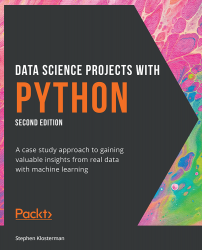Python and the Anaconda Package Management System
In this book, we will use the Python programming language. Python is a top language for data science and is one of the fastest-growing programming languages. A commonly cited reason for Python's popularity is that it is easy to learn. If you have Python experience, that's great; however, if you have experience with other languages, such as C, Matlab, or R, you shouldn't have much trouble using Python. You should be familiar with the general constructs of computer programming to get the most out of this book. Examples of such constructs are for loops and if statements that guide the control flow of a program. No matter what language you have used, you are likely familiar with these constructs, which you will also find in Python.
A key feature of Python that is different from some other languages is that it is zero-indexed; in other words, the first element of an ordered collection has an index of 0. Python also...



